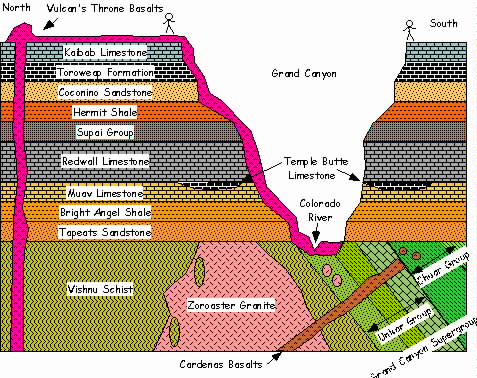

Notice that there is a tilted sequence of rocks beneath the flat-lying layers. If we straighten these folded layers, the oldest rock is the Vishnu Schist. It must be older than the Zoraster Granite because their are inclusions of Schist in the granite. Inclusions mean that rock is older.
There are also inclusions of the Zoraster Granite in the bottom layers of the Unkar Group. This means the Granite is older than the Unkar Group.
Because the Granite and Schist are deep rocks and the Unkar Group consists of layered sedimentary rocks, there must be a nonconformity between them.
After the erosion that produced the nonconformity, the Unkar Group was deposited (Please note that the patterns representing the Unkar and Chuar Groups simply represent that these groups contain multiple formations. The number and rock types of the actual formations are not accurately represented).
The Unkar Group was then intruded by the Cardenas Basalts (cross cutting relationships). But this happened prior to the deposition of the Chuar Group because there are inclusions of the basalts in the Chuar Group.
Therefore, there must be a disconformity between the Unkar and Chuar Groups.
After deposition of the Chuar Group, the entire lower part must have been tilted but prior to the deposition of the Tapeats Sandstone. We know this by the Principle of Original Horizontality.
But the mountains formed by the tilting have been eroded to flat. Therefore there is an angular unconformity between the Grand Canyon Supergroup and the Tapeats Sandstone.
Then comes the deposition of the Bright Angel Shale and the Muav Limestone.
After that the Muav Limestone was eroded and the Temple Butte Limestone was deposited in channels cut into the Muav. Therefore there must be another disconformity between the Muav and the Temple Butte Limestone.
But the Temple Butte Limestone has been eroded also (it is not a continuous layer). Therefore there must be another disconformity between the Temple Butte and the Redwall.
Then follows the deposition of the Redwall through Kaibab Limetone sequence by simple superposition.
The cutting of the Grand Canyon itself comes next. We know this by the Principle of Lateral Continuity. The rocks on the cliff with the stickperson are the same as the rocks on the other cliff. Therefore the canyon must be younger than those rocks.
But the basalts of Vulcan's Throne flow into an already existing canyon. Therefore they are the youngest geologic feature in the area.